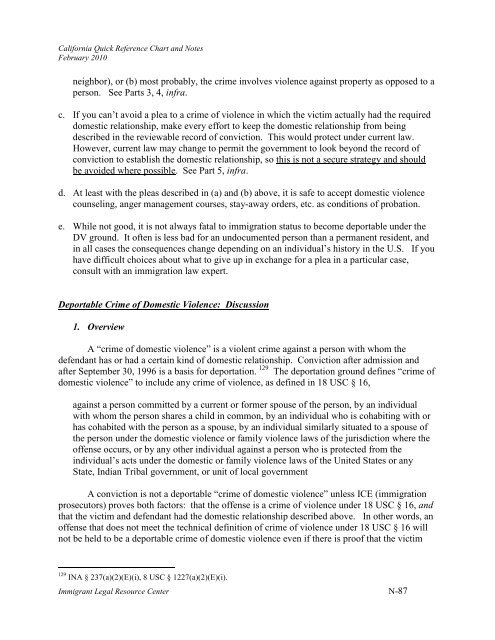quick reference chart and notes for determining immigration - ILRC
quick reference chart and notes for determining immigration - ILRC
quick reference chart and notes for determining immigration - ILRC
You also want an ePaper? Increase the reach of your titles
YUMPU automatically turns print PDFs into web optimized ePapers that Google loves.
Cali<strong>for</strong>nia Quick Reference Chart <strong>and</strong> Notes<br />
February 2010<br />
neighbor), or (b) most probably, the crime involves violence against property as opposed to a<br />
person. See Parts 3, 4, infra.<br />
c. If you can’t avoid a plea to a crime of violence in which the victim actually had the required<br />
domestic relationship, make every ef<strong>for</strong>t to keep the domestic relationship from being<br />
described in the reviewable record of conviction. This would protect under current law.<br />
However, current law may change to permit the government to look beyond the record of<br />
conviction to establish the domestic relationship, so this is not a secure strategy <strong>and</strong> should<br />
be avoided where possible. See Part 5, infra.<br />
d. At least with the pleas described in (a) <strong>and</strong> (b) above, it is safe to accept domestic violence<br />
counseling, anger management courses, stay-away orders, etc. as conditions of probation.<br />
e. While not good, it is not always fatal to <strong>immigration</strong> status to become deportable under the<br />
DV ground. It often is less bad <strong>for</strong> an undocumented person than a permanent resident, <strong>and</strong><br />
in all cases the consequences change depending on an individual’s history in the U.S. If you<br />
have difficult choices about what to give up in exchange <strong>for</strong> a plea in a particular case,<br />
consult with an <strong>immigration</strong> law expert.<br />
Deportable Crime of Domestic Violence: Discussion<br />
1. Overview<br />
A “crime of domestic violence” is a violent crime against a person with whom the<br />
defendant has or had a certain kind of domestic relationship. Conviction after admission <strong>and</strong><br />
after September 30, 1996 is a basis <strong>for</strong> deportation. 129 The deportation ground defines “crime of<br />
domestic violence” to include any crime of violence, as defined in 18 USC § 16,<br />
against a person committed by a current or <strong>for</strong>mer spouse of the person, by an individual<br />
with whom the person shares a child in common, by an individual who is cohabiting with or<br />
has cohabited with the person as a spouse, by an individual similarly situated to a spouse of<br />
the person under the domestic violence or family violence laws of the jurisdiction where the<br />
offense occurs, or by any other individual against a person who is protected from the<br />
individual’s acts under the domestic or family violence laws of the United States or any<br />
State, Indian Tribal government, or unit of local government<br />
A conviction is not a deportable “crime of domestic violence” unless ICE (<strong>immigration</strong><br />
prosecutors) proves both factors: that the offense is a crime of violence under 18 USC § 16, <strong>and</strong><br />
that the victim <strong>and</strong> defendant had the domestic relationship described above. In other words, an<br />
offense that does not meet the technical definition of crime of violence under 18 USC § 16 will<br />
not be held to be a deportable crime of domestic violence even if there is proof that the victim<br />
129 INA § 237(a)(2)(E)(i), 8 USC § 1227(a)(2)(E)(i).<br />
Immigrant Legal Resource Center N-87

















